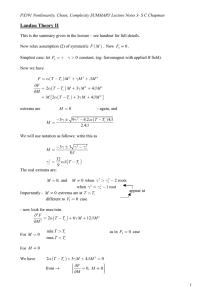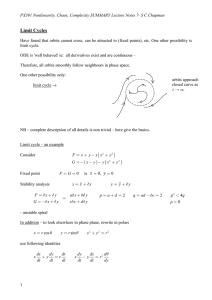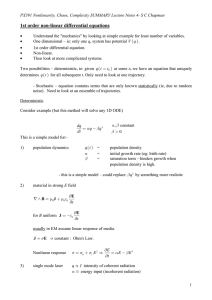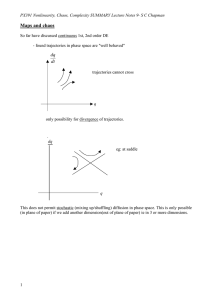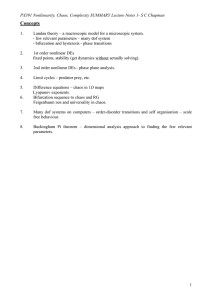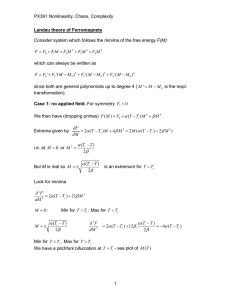( )
advertisement
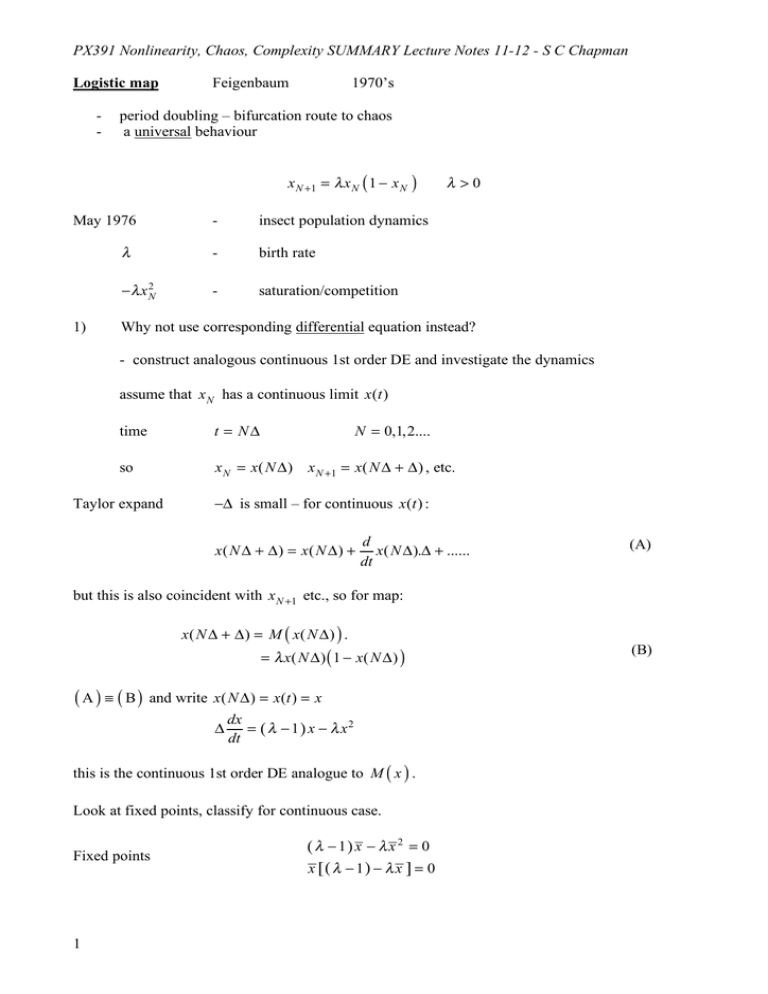
PX391 Nonlinearity, Chaos, Complexity SUMMARY Lecture Notes 11-12 - S C Chapman Logistic map - Feigenbaum 1970’s period doubling – bifurcation route to chaos a universal behaviour x N +1 = ! x N ( 1 " x N May 1976 1) ) - insect population dynamics ! - birth rate ! " x N2 - saturation/competition !>0 Why not use corresponding differential equation instead? - construct analogous continuous 1st order DE and investigate the dynamics assume that x N has a continuous limit x(t) time t = N! so x N = x(N !) Taylor expand N = 0,1,2.... x N +1 = x(N ! + !) , etc. !" is small – for continuous x(t) : x(N ! + !) = x(N !) + d x(N !).! + ...... dt (A) but this is also coincident with x N +1 etc., so for map: x(N ! + !) = M ( x(N !) ) . = ! x(N ") ( 1 # x(N ") ) ( A ) ! ( B ) and write x(N !) = x(t) = x " dx = ( ! # 1 ) x # ! x2 dt this is the continuous 1st order DE analogue to M ( x ) . Look at fixed points, classify for continuous case. Fixed points 1 ( ! " 1) x " ! x 2 = 0 x [( ! " 1) " ! x ] = 0 (B) PX391 Nonlinearity, Chaos, Complexity SUMMARY Lecture Notes 11-12 - S C Chapman so x = 0, x= ! "1 . ! Classify by sketching the phase plane H (x) = " dx = ( ! # 1 ) x # ! x2 dt ! does not matter sketch H (x) vz x !>0 so H ( x ) ! "# x ! ±# t.p at dH = 0 = ( ! " 1 ) " 2! x dx ie: at x = ! "1 2! or x= x 2 Sketch of phase plane ● x Then for the continuous DE: ● x ! >1 0 < ! <1 2 H(x) 0 < ! <1 H(x) ! >1 ● ● x x x =0 ! "1 x= ! repellor x =0 attractor attractor x x PX391 Nonlinearity, Chaos, Complexity SUMMARY Lecture Notes 11-12 - S C Chapman x= ! "1 ! repellor Now look at the difference equation (map) x N +1 = ! x N ( 1 " x N ) x N +1 = x N = x fixed points at x = ! x (1 " x ) ( ! " 1) x " ! x 2 = 0 ie: Classify: - same expression as continuous DE. Linearize the map xN = x + ! xN x N +1 = x + ! x N +1 Sub into map x + ! xN +1 = " ( x + ! xN ) (1 # x # ! xN ) = " $& x (1 # x ) # x! xN + (1 # x )! xN # ! xN2 %' but at the fixed points x = ! x (1 " x ) N +1 = [ ! (1 # 2 x ) ] and at x = 0 x= so +0 (! xN2 ! xN +1 = "! xN (1 # 2 x ) so ! "1 ! x =0 x= ! "1 ! " x0 ! xN +1 = " N +1! x0 " xN +1 ! # 2! + 2 & ' = $* ! %( )+ ! , ./ N +1 " x0 " xN +1 = ( 2 # ! )N +1 " x0 ! >1 0 < ! <1 x =0 x =0 repellor attractor -same as continuous DE - for 0 < ! < 1 is a repellor- same as continuous DE however, no longer an attractor for all ! > 1 different to continuous DE 3 ) PX391 Nonlinearity, Chaos, Complexity SUMMARY Lecture Notes 11-12 - S C Chapman 2! " <1 instead, for 1 < ! < 3 map has attractor at x = i.e ! "1 ! What happens for ! > 3 ? ! >1 Sketch of map: M(x) M ( x ) = !x (1 " x ) intercepts at x = 0,1 dM = ! " 2! x dx 1 = 0 at x = 2 !# 1& ! M 12 = % 1 " ( = 2$ 2' 4 ( ) x is bounded ie: x ! [ 0,1 ] if ! " 4 ! 4 ● 0 1 2 ● 1 We will look in the range 3 < ! < 4 (this is where all the interesting behaviour is). First we can do ! = 4 in this case M p ( x ) = [ 0,1 ] (like tent map). Topologically, same as tent map as well – see this by change of variables " !y% 1 x = sin 2 $ = [ 1 ( cos ( ! y ) ] # 2 '& 2 x = [ 0,1 ] as y = [ 0,1 ] sub into xN +1 = 4 xN (1 ! xN ) "!y % 1 1 " % sin 2 $ N +1 ' = 2 ( 1 ( cos ! y N ) $ 1 ( + cos ! y N ' # & 2 2 # 2 & = ( 1 ! cos " y N 4 ) ( 1 + cos " yN ) = 1 ! cos2 ( " yN ) = sin 2 ( " yN ) x PX391 Nonlinearity, Chaos, Complexity SUMMARY Lecture Notes 11-12 - S C Chapman ie: "!y % sin 2 $ N +1 ' = sin 2 ( ! y N # 2 & so ! y N +1 = ±! y N + S ! 2 ) S integer y = [ 0,1 ] so can only have certain s. y N +1 = ± yN + S 2 If S =0 y N +1 = 2 y N S =1 y N +1 = 2 ( 1 ! y N 0 ! yN ! ) 1 2 1 2 ! yN ! 1 + sign - sign this is just the tent map. So, have shown there is global chaos at ! = 4 Problem – what happens as we go from ! < 3 attractor to ! = 4 We will need to find the pth iterated map M p (or its essential properties). 5 - chaos? PX391 Nonlinearity, Chaos, Complexity SUMMARY Lecture Notes 11-12 - S C Chapman Iterates of the logistic map (use graphics) Sketch M ! 4 M(x) = x ● x= slope < 1 stable 1< ! < 3 ! "1 ! ● x ● 0 1 2 ! 4 M(x) = x ● 3< ! < 4 ● x= ! "1 ! 0 goes 1 2 stable → unstable attractor → repellor as ! goes through 3. 6 ● 1 PX391 Nonlinearity, Chaos, Complexity SUMMARY Lecture Notes 11-12 - S C Chapman Look at M 2 ( x ) M 2 ( x ) = M ( M ( x )) = ! M (1 " M ) = ! 2 x (1 " x ) (1 " ! x (1 " x ) ) ! = ! 2 #% x " (1 + ! ) x 2 + 2! x3 " ! x 4 $& fixed points of M 2 ( x ) are M 2 ( x ) = x or M2(x )! x = 0 or ! 2 "% x $ (1 + ! ) x 2 + 2! x 3 $ ! x 4 #& $ x = 0 x = 0 and 3 others. so roots are - 3 real or 1 real, 2 imaginary - all depends on ! . Sketch M 2 ( x ) - it is a quadratic - it is symmetric about x = (because M is) asymptotes M 2 ( x ) ! "# intercepts at x = 0,1 7 x ! ±# 1 2 PX391 Nonlinearity, Chaos, Complexity SUMMARY Lecture Notes 11-12 - S C Chapman M2(x) Sketch M2( x) = x !<3 M2( x) = x !>3 2 1 ● ● ● ● ● 0 ● 0 1 1 2 1 2 Fixed points: x =0 x =0 +1 Now if x is a fixed point of M must be fixed point of M call this x* 2 (converse is not time) !<3 !>3 - 8 ! "1 x = is attractor ! * x * is repellor ( d M2 dx ) <1 x* d (M 2 ) > 1 and dx but two new fixed points appear they may (may not) be attractive. dM >1 dx +3 1 PX391 Nonlinearity, Chaos, Complexity SUMMARY Lecture Notes 11-12 - S C Chapman 3< ! < 4 x* = ! "1 ! is repulsive fixed point of M , M 2 .... but two new fixed points of M 2 appear at ! > 3 not fixed points of M . If these are attractive this is period 2 cycle of M . M (x) Period 2 in M is fixed point of M 2 . Local gradients to x , ie: ! must be "just right". See handout for the full sequence…. 9 PX391 Nonlinearity, Chaos, Complexity SUMMARY Lecture Notes 11-12 - S C Chapman Logistic map and Feigenbaum numbers As ! increases there are successive period doublings x x* !1 = 3 Pairs of bifurcated fixed points Separated by !x p appear at ! p - looks "self similar". 10 !2 !3 !" ! PX391 Nonlinearity, Chaos, Complexity SUMMARY Lecture Notes 11-12 - S C Chapman Self – similar? A piece of the sequence (a) !" p • ! "x p enlarge x • (b) ! !p ! p"1 !" p = " p # " p#1 looks the same !x p = x p(A) " x p( B ) If self similar then !" p !" p+1 !x p !x p+1 = const ratio independent of p = const indepenent of p Feigenbaum's result (numerical) – found by playing on calculator! !" p !" p+1 !x p !x p+1 # $ F = 4.66920.... " # F = 2.59029..... - these are "universal" numbers ! F , " F - same for many such maps – originally thought for all maps. actually turn out to be for all quadratic maps. (Find why this is so.) 11 PX391 Nonlinearity, Chaos, Complexity SUMMARY Lecture Notes 11-12 - S C Chapman - this is a 'universality class' (show this next). First note since ! F , " F are constants show next there is a termination to the sequence at !" . beyond this – global chaos. ( ! bifurcations, ! close together) + some interesting islands of periodic 'superstable' behaviour. What is !" ? We have (just depends on ! F and a const.) $! p ! p # ! p #1 = = "F $! p +1 ! p +1 # ! p and !" = lim ! p p#" now !" p = So we write !" p#1 $F = !" p#2 $ F2 , etc. !# = ! p + $! p +1 + $! p + 2 + .... = !p + $! p $! p + 2 + .... "F "F but ! F > 1 so roughly (lowest order in ! F ) #! p # !" ! ! p + = ! p + p0 $F $F or ! p = !" # C C = some const, ie: ! 0 $ Fp thus !" depends on details of the maps, ie: C- Not universal. Universal behaviour is the period doubling ( ! F ," F ) , sequence and the existence of some !" . Other universality classes: There is a family of maps f ( x) = 1! a x - different ! F , " F one for each q. 12 q
